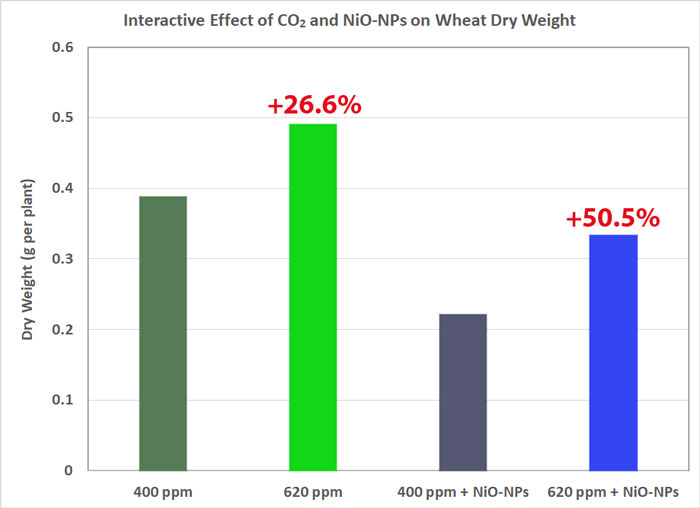| Tweet | Follow @co2science |
Paper Reviewed
Saleh, A.M., Hassan, Y.M., Selim, S. and AbdElgawad, H. 2019. NiO-nanoparticles induce reduced phytotoxic hazards in wheat (Triticum aestivum L.) grown under future climate CO2. Chemosphere 220: 1047-1057.
Nano-sized nickel oxide particles (NiO-NPs) have increasingly been used in consumer products over the past few decades, including batteries, gas sensors and electrochromic devices. According to Saleh et al. (2019), these small-sized heavy metals inevitably find their way into the environment and can cause biological toxicity if present in sufficient quantities. Thus, the team of four researchers opine that "substantial efforts should be given to develop efficient approaches for alleviating the impact of such pollutants on plant productivity and limiting their accumulation in the edible parts of the plant."
Seeking to provide a scientific basis for such efforts, Saleh et al. conducted an experiment to examine the effects of NiO-NPs on the growth of wheat plants, while also examining the impacts of elevated CO2 both alone and in combination with NiO-NP toxicity. The four specific treatments included (1) ambient CO2 (400 ppm), (2) ambient CO2 plus NiO-NP contamination (120 mg/kg soil), (3) elevated CO2 (620 ppm) and (4) elevated CO2 plus NiO-NP contamination (120 mg/kg soil). Plants in all treatments were grown in controlled-environment chambers from seed. One week after sowing the NiO-NPs were applied in respective treatments. Three weeks later the plants were analyzed and harvested.
So what did their study reveal?
It came as no surprise that NiO-NPs reduced biomass production, whereas elevated CO2 enhanced it (see Figure 1). However, as Selah et al. note, "the NiO-NPs-induced biomasses reduction was much lower under elevated CO2 than under ambient CO2" (also see Figure 1).
NiO-NP contamination also had an inhibitory influence on photosynthesis and induced severe oxidative stress. In contrast, elevated CO2 promoted photosynthesis and repressed photorespiration, which combination of processes resulted in reduced reactive oxygen species production and improvement of antioxidant defenses. Thus, according the authors, "the coexistence of elevated CO2 with NiO-NPs significantly mitigates the Ni-induced oxidative stress," which mitigating effect led them to conclude that "wheat plants will be more tolerant to NiO-NPs stress under future climate [with increasing] CO2."

Figure 1. Effect of CO2 (400 or 620 ppm) and NiO-NPs (without or with 120 mg/kg soil), and their combination, on the total (shoot + root) dry weight production of wheat. The numbers in red reveal the percent difference in dry weights between the ambient and elevated CO2 treatments (green shaded bars), without and with NiO-NPs (blue shaded bars). Source: created from data presented in Table 1 of Selah et al. (2019).




